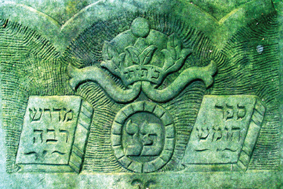Are you a journalist? Please sign up here for our press releases
Subscribe to our monthly newsletter:
 and Polish volunteers. Past and future.jpg)
Remembering someone you loved bestows a form of eternal life on that person. This is the message of the play The Blue Bird by Belgian poet and Nobel laureate Maurice Maeterlinck. Another Belgian, Prof. Daniel Wagner of the Weizmann Institute's Materials and Interfaces Department, has taken Maeterlinck’s message to heart: He has undertaken to preserve the memory of those once loved and now forgotten.
Scattered headstones dating from 1828 denote the graves of some 3,000 Jews buried in the cemetery in Zdunska Wola – one of the largest Jewish cemeteries in Poland. The latest burial date – 1942 – signifies not only the end of one life but the passing of an entire community. Upon arriving at the site in search of ancestors, Wagner was so moved by the scene before him he pledged to undertake a cemetery census project. “Commitment to this research is much more than a rational act,” says Wagner. “It involves passion and something irresistible.”
The chaos resulting from more than 50 years of neglect and vandalism did not discourage him. Wagner approached the challenge of establishing order in a systematic way, setting goals to explore the site thoroughly and to identify and document all headstones – a painstaking, time-consuming process involving clearing, cleaning, mapping, labeling, photographing and deciphering names and texts.
Many headstones had been moved or were toppled and long ago buried under layers of earth and debris, but every new discovery revealed a work of art. Colorfully painted and decorated in great detail, the headstones are relics of a lost Jewish tradition once practiced throughout Poland. Some symbols are easily understood as representing the identity of the deceased; but others are less obvious: mythical griffins, lavishly ornamented crowns, potted flowering plants, strange birds, boats with broken masts, even a ship facing a large fish. Some of the texts tell stories – including tales of crime or love.
From the beginning, Wagner sought assistance from the residents of Zdunska Wola – none of them Jewish. He promoted pride of ownership: “In many ways, this cemetery belongs as much to the local Polish community as to the Jewish people.” Townspeople participate in clearing and cleaning. For the tasks of mapping and recording, Wagner works closely with three local women who are committed to the project. In his absence, they serve as contacts or guides for other information seekers and for visitors from around the world.
Keen to share information on this vanished culture, Wagner developed a lecture on Jewish traditions, which he presents to Polish high school students several times each year. Other activities include an annual competition of Polish students’ projects on the topic of the Jewish presence in Zdunska Wola and the participation of Israeli youth in the cemetery renewal project. A few local students have even studied Hebrew under Wagner and now provide graveside translations of tombstones for an annual cemetery “open house.” Inspired by this achievement, Wagner is writing a guide, “Hebrew Tombstone Interpretation,” which he hopes will be a useful tool for research in Jewish cemeteries throughout the world.

Wagner has embarked on a systematic compilation of photographs, records and stories for the purpose of publishing a book on the cemetery and the Jewish community of Zdunska Wola. His progress so far has resulted in the creation of a website, including a “Family Finder,” to aid other researchers.
Wagner: “The ultimate success of this research will be measured in terms of the site's future. It remains to be seen if the work undertaken so far will be preserved and proper restoration continued, and this depends on many things, not the least of which is the ongoing support of the local community.”
Wagner, who is at present chairman of the Zdunska Wola Organization in Israel, plans to pursue designation of the cemetery as a national historical monument of Poland.
In 1997, after a winding climb up the family tree, Wagner came face-to-face with his great-grandfather – deceased some 60 years. Actor Morris (Moishe) Silberkasten had indeed materialized as an apparition of sorts: Wagner was able to track down a restored American-made Yiddish movie from the 1930s in which his great-grandfather had performed. Through these priceless motion-picture moments, Wagner “met” his great-grandfather, who had emigrated from Poland to America in 1916 via China and Japan and is buried in the Jewish Theater Actors section of Mount Hebron cemetery in Brooklyn, NY.
Prof. Daniel Wagner is the incumbent of the Livio Norzi Professorial Chair.